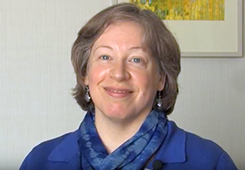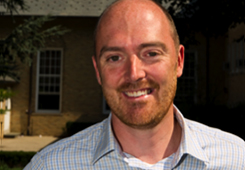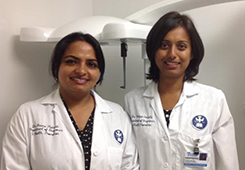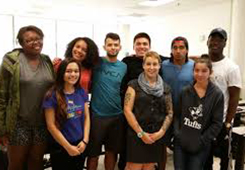Strategies for Engaging Individual Learners in a Large Lecture Course
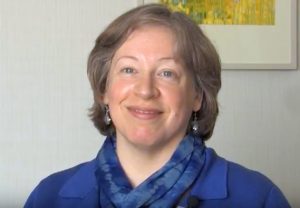
Diane McKay, Assistant Professor at the Friedman School of Nutrition Science and Policy, discusses how she introduced a new “teaching with technology” practice to make her large lecture class engaging for undergraduate students who are non-science majors.
Earlier this year, you faced a challenge of teaching nutrition science to a large lecture class of 150 undergraduate students. How did you approach this class-size challenge at the beginning?
This was a unusually large class size for me, one I had never dealt with during my teaching career. When faced with this challenge, I wanted to apply what I was learning at that time from my interactions with a small group of faculty and CELT about creating an inclusive learning environment. I was particularly interested in helping students who are less prepared for the science aspects of my nutrition science course. One of my main takeaways from the faculty learning community experience was to be more intentional about creating a sense of community among my students. The first practical step for me was to find ways to encourage the students to attend the 3-hour long weekly lectures and to participate together as part of a large learning community.
Due to the size of this class, I also wanted a technology-based solution so I could be more systematic about understanding the needs of individual learners, in addition to checking attendance. I used Learning Catalytics, a web-based realtime student response tool, and gave my students points towards a small percentage of their grade for participating via this tool as an incentive to come to class. Students were asked to respond to my questions digitally via their laptop, tablet or smartphone so I could check for their understanding of specific concepts during my lectures, and give them immediate feedback on their responses. I believe it kept the students engaged for the three hour classes, and I know it kept me engaged.
I also tried to get students talking to each other to help build a sense of community. On the first day of class, I did an icebreaker exercise that required students to introduce themselves to several other people. They all got up out of their seats, turned to one another, started to shake hands. It was so much fun to watch! That bonding experience was helpful later on when I asked them to pair up with their neighbor and work together on some of the Learning Catalytics questions.
In addition to using Learning Catalytics on a regular basis to encourage lecture attendance, you redesigned one lecture on a difficult topic. Tell us more how you approached redesigning that lecture.
For non-science majors to find personal relevance in the materials presented, my students work on a semester-long project requiring them to analyze their own dietary intake and apply what they learn throughout the course. My interest in promoting this project-based learning comes from two guiding questions: What do I really need them to know and take away from this course so they can find the knowledge usable in their real life? What kind of scientific and critical thinking skills is this class going to help them develop so they can better take care of themselves and others?
Chunking the final project to mini parts
For many years I required students to submit one large, all-encompassing project at the end of the semester, and often noted evidence of students’ misconceptions in some sections of their final work. In retrospect, wish I had intervened earlier and provided feedback more frequently so these misconceptions were not perpetuated. So, this time, I divided the project into smaller, more manageable chunks that were due periodically throughout the semester, each in conjunction with a specific unit. That is, students completed the 6 individual sections of their project as the semester progressed. By completing each part as the relevant material was being presented, they continually had a chance to think about how what they learned each week could be used in real life.
Modeling how I would solve a problem
I also worked with the educational technology team to take how I would normally use Learning Catalytics (LC) to the next level. The goal was to pick a lecture related to one particularly difficult section of their project, and create a series of Learning Catalytics questions in a way to exercise deeper learning. In my class, I have mostly Arts or English majors who don’t deal with numbers often or who might sometimes feel intimidated by them. To help reduce their anxiety, I decided to provide concrete examples of a successful assignment and walk them through it step by step. I was very explicit about what I needed them to do for that assignment, what specific data I needed them to refer to from the intial data they collected, how to use and analyze that data, and what was expected in their write-up.
I selected the class session on minerals and spent the three hours in the following way:
- During the first two hours, I lectured on the essential minerals and, in that lecture, showed the class how to interpret a dietary reference chart to determine whether a particular dietary intake level might be considered a nutrient toxicity or deficiency. While I explained the concept, I annotated on the presentation slides using my tablet laptop so the students could follow along and hone in on the parts of the lecture they would need to refer to in their project. Typical LC questions were asked during the lecture to check for their understanding of the concepts that were covered.
- Then, the last hour of my lecture turned into a case presentation to teach them how to synthesize the information. Using a sample set of dietary intake data, they practiced interpreting the information on the reference chart and making recommendations for balancing that person’s diet. This exercise prepared them to do their own diet analysis assignment during the following week. I walked them through a series of LC questions specifically designed to help them follow the case presentation.
- I tried to keep this information as accessible as possible for those who missed the class due to the spring break, or those who simply needed to take enough time to review the material and process the example, before they tackled their own project. I prepared the LC case presentation questions in the “self-test” mode, which gave me the option of delivering the questions asynchronously online with an extended period for participation. I also recorded this case presentation walkthrough using the Echo360 Classroom Capture and made it available until this part of their project was due. In the end, I had few follow-up emails requesting clarification about this part of the assignment compared with previous years. Even then, I was able to just refer students to the recording.
The real key to success was coming up with appropriate Learning Catalytics questions that were different from the weekly quizzes, which typically focus on factual recall. These in-class LC questions need to be written in a way to summarize what was discussed in class or help students apply concepts personally. For example, “What is the correct sequence of events in this process?” “Which one of these foods provides the highest amount of this nutrient?” “How could you make this meal better?”
What are your next steps?
I’m going to continue using Learning Catalytics in all my face-to-face courses, especially my three-hour-long summer class scheduled in the evening.

